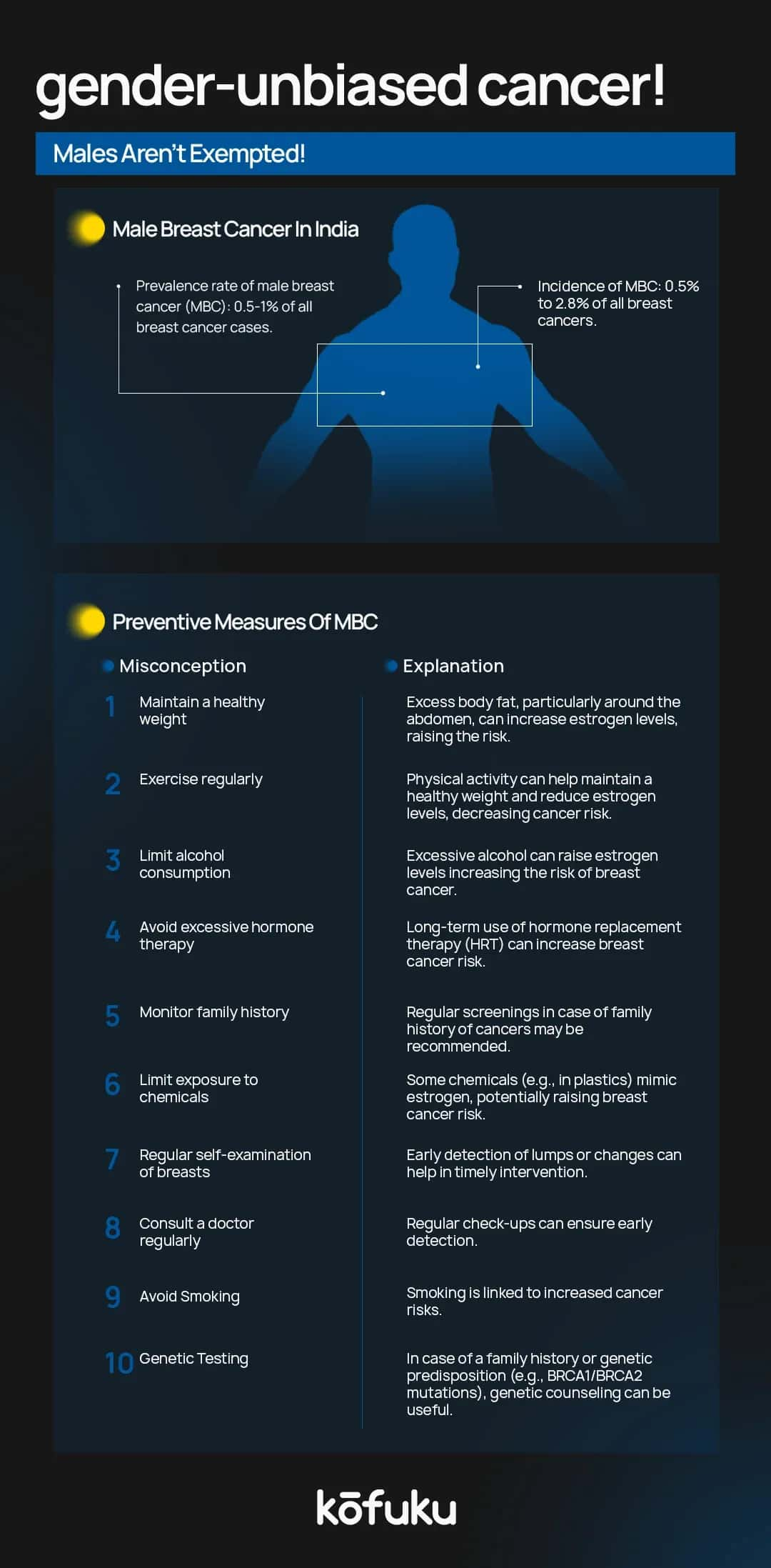The Detailed Guide To Male Breast Cancer

Introduction
You might think that breast cancer affects only women, and we can’t blame you for it. It literally has the word ‘breast’ in it. But that’s far from the truth. However, one in about 725 men suffer from breast cancer. That adds up to about 5,00,000 men worldwide.
So, you might think that the disease is rare, but understanding its causes, symptoms, diagnosis, treatment, and prognosis can go a long way for you and your friends. We’ve compiled a male breast cancer guide so you can have all your information consolidated in just this one blog!
How Rare Is It?
Male breast cancer is rare, accounting for less than 1% of all breast cancer cases. According to the American Cancer Society, approximately 2,600 new cases of male breast cancer are diagnosed each year in the U.S., with around 500 deaths. That gives it a death rate of 19.2%.
Although it is far less common than female breast cancer, men should still be aware of the risk factors and symptoms so they can detect it early and be safe..
Causes and Risk Factors of Male Breast Cancer
There are many factors that contribute to the development of breast cancer in men, so let’s take a look at the most common ones:
Genetics and Family History
Men with a family history of breast cancer, especially those with BRCA1 or BRCA2 gene mutations, have a higher risk of getting the disease.
Hormonal Imbalance
Too much estrogen or too few testosterone levels can increase the risk of breast cancer in men. There are conditions like the Klinefelter syndrome, which causes higher estrogen levels, which can also be a risk factor.
Age
Most cases of male breast cancer occur in men over 60 years old, however, there are still chances of young men getting it, albeit small.
Radiation Exposure
Men who have undergone radiation therapy to the chest area or generally work around factories with high radiation have a higher risk of developing breast cancer.
Liver Disease
Liver conditions like cirrhosis can disrupt hormone balance, leading to lower androgen levels and higher estrogen levels and in turn, a higher risk.
Obesity
Excess fat tissue can produce estrogen, which can contribute to breast cancer development.

Symptoms and Signs of Male Breast Cancer
The early symptoms of male breast cancer are many times ignored or maybe even mistaken for other not so serious conditions. Here are some common symptoms:
-
A lump or swelling in the breast tissue
-
Changes in the skin texture, such as dimpling or puckering
-
Nipple retraction or inversion
-
Redness or scaly skin around the nipple
-
Nipple discharge, sometimes bloody
-
Pain or tenderness in the breast area
Diagnosis of Male Breast Cancer
When you detect it early, it can significantly improve the survival rates. There are many tests that can be done to diagnose male breast cancer including:
Clinical Breast Exam
In true Grey’s Anatomy style, a doctor examines the breast for lumps, skin changes, and abnormalities.
Mammogram
Though often associated with women, mammograms can be used to detect abnormalities in men too.
Ultrasound
This imaging test helps differentiate between solid tumors and cysts.
Biopsy
A fine needle is used to collect tissue and then it’s sent to the lab for analysis.
Hormone Receptor Testing
It’s generally used to determine whether the cancer is hormone receptor-positive and helps with further treatment options.
Stages of Male Breast Cancer
The staging of male breast cancer determines its severity and treatment approach. Stages range from 0 to IV depending on tumor size, lymph node involvement, and metastasis.
Stage 0: Non-invasive cancer (ductal carcinoma in situ)
Stage I: Small tumor with no lymph node spread
Stage II: Larger tumor or small lymph node involvement
Stage III: Extensive lymph node involvement
Stage IV: Cancer has spread to other organs (metastatic)
Treatment Options for Male Breast Cancer
Treatment for male breast cancer can be a hard and sometimes painful process, but it mainly depends on the stage and characteristics of the cancer. Here are some common treatments that are used:
Surgery
-
Mastectomy: The most common treatment which involves the removal of the affected breast tissue.
-
Lymph Node Dissection: If cancer has spread to lymph nodes, they may have to be removed surgically.
Radiation Therapy
It is done after surgery to eliminate any remaining cancer cells and reduce the chances of it occurring again.
Hormone Therapy
Since most male breast cancers are hormone receptor-positive, treatments like Tamoxifen help block the effects of estrogen.
Chemotherapy
It is used when the cancer has spread beyond the breast, which helps to reduce or even eliminate tumors all over the body.
Targeted Therapy
Drugs like Trastuzumab (Herceptin) can be used for HER2-positive cancers. They target the protein and kill it at the source so it cannot spread.
Male Breast Cancer vs Female Breast Cancer
Even though they are both called breast cancer, male breast cancer is different in some important aspects:
-
Rarer in men and usually diagnosed at later stages
-
More likely to be hormone receptor-positive, making hormone therapy effective
-
Less awareness, leading to delayed diagnosis
-
Different surgical approaches, as men have less breast tissue

Male Breast Cancer Prognosis and Survival Rates
The prognosis depends on the stage at diagnosis. However, according to the American Cancer Society, Stage I has a survival rate of about 95%. Stage II has a survival rate of around 88%, Stage III has a survival rate of around 75%, while Stage IV drops to 25%.
Unfortunately, most people fall into the third and 4th category, which is why many people don’t survive this disease.
Prevention and Early Detection of Male Breast Cancer
Unfortunately, breast cancer in men cannot always be prevented but some measures can be taken to reduce the risk:
-
Regular self-examinations to detect lumps early
-
Maintaining a healthy weight
-
Limiting drinks
-
Managing hormone levels if it is at risk
-
Genetic testing for BRCA mutations if there is a strong family history
-
Annual check-ups, especially for those who are at risk
There is a lot of ongoing research that aims to improve treatment options and survival rates. New targeted therapies for hormone-resistant cancers are heavily funded research, with genetic studies to identify high-risk people also taking a front seat.
There have also been many advancements in immunotherapy, so we will regularly update this blog whenever there’s a breakthrough.
Male Breast Cancer Recovery and Life After Treatment
There’s no one size fits all because recovery depends on the stage and treatment. Many survivors lead normal lives after treatment, though they may experience:
-
Side effects of hormone therapy (hot flashes, fatigue)
-
Physical changes post-mastectomy
-
Mental health challenges (anxiety, depression)
-
Support from family, healthcare providers, and counselling can help in the recovery process and even with the patient’s mental well-being.
Conclusion
Cancer is a disease that attacks not only your body and how it functions but also your mind and how you live. Famous ESPN commentator, Stuart Scott couldn’t have said it better, “You beat cancer by how you live, why you live, and in the manner in which you live.”
Just know that it takes a lot to be with your loved ones who have cancer and even more to beat it.
FAQs
What is male breast cancer?
Male breast cancer is a rare condition where cancer cells form in the breast tissue of men. While it is more commonly found in women, men can develop breast cancer too, typically starting in the milk ducts.
What are the symptoms of male breast cancer?
Symptoms may include a lump in the breast tissue, changes in the shape or size of the breast, pain or tenderness in the nipple, or discharge from the nipple. Men should be alert to any unusual changes and consult a doctor if they notice any of these signs.
What causes male breast cancer?
The exact cause isn't always clear, but risk factors include genetic mutations (like BRCA1 or BRCA2), a family history of breast cancer, high estrogen levels, liver disease, radiation exposure, and certain lifestyle factors.
How is male breast cancer diagnosed?
Diagnosis involves a combination of physical exams, mammograms, ultrasounds, and biopsies. A doctor will assess the breast tissue and may perform imaging tests to check for any abnormalities.
What are the treatment options for male breast cancer?
Treatment typically includes surgery to remove the tumor or breast tissue, radiation therapy, chemotherapy, and hormone therapy, depending on the stage and type of cancer. Treatment plans are personalised based on the individual's condition.




